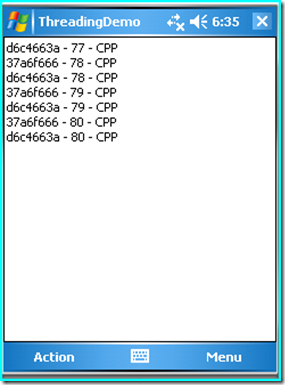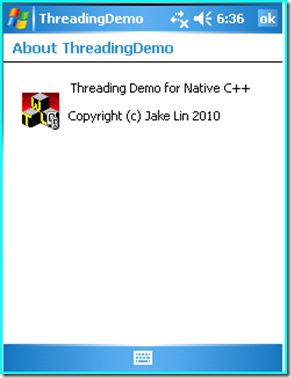Windows Mobile使用Native C++开发多线程程序
简介
上一篇文章 Windows Mobile使用.NET Compact Framework开发多线程程序 讲述了如何使用.NET Compact Framework进行多线程程序的开发,这篇讲述Native C++开发多线程程序的方法。
实现
环境
Environment: Visual Studio 2008 + Native C++ + WTL 8.1 + Windows Mobile 5.0 R2 professional (VS 2008 built-in) + ARMV4I
类定义 Class Definition
public:
void SendRequest();
void HandleRequest();
private:
HANDLE volatile mHandlerEvent;
HANDLE mHandlerThreadHnd;
DWORD mHandlerThreadId;
HANDLE mRequesterThreadHnd;
DWORD mRequesterThreadId;
MessageQueue mMessageQueue;
CRITICAL_SECTION mLook;
bool volatile mStarted;
private:
void UpdateMessageList(const CString& msg);
void StartThreading();
void StopThreading();
mHandlerEvent is the event to wake up handler thread.
mHandlerThreadHnd is the handler thread’s handle.
mHandlerThreadId is the handler thread’s Id
mMessageQueue is the shared resource. I use STL queue to encapsulate it.
mLook is a CRITICAL_SECTION object and is used to lock the shared resource.
mHandlerEvent 用于唤醒处理线程的事件。
mHandlerThreadHnd 线程句柄。
mHandlerThreadId 线程ID。
mMessageQueue STL的queue,共享资源,用于线程间分享数据。
mLook 是 CRITICAL_SECTION 对象,用于线程间的加锁。
Start two threads
// Handler thread methods
DWORD WINAPI HanlderThreadProc(void *param)
{
if (param)
{
try
{
CThreadingDemoView* view = (CThreadingDemoView*)param;
view->HandleRequest();
}
catch(...)
{
}
}
return 0;
}
// Requester thread methods
DWORD WINAPI RequesterThreadProc(void *param)
{
if (param)
{
try
{
CThreadingDemoView* view = (CThreadingDemoView*)param;
view->SendRequest();
}
catch(...)
{
}
}
return 0;
}
void CThreadingDemoView::StartThreading()
{
if(!mStarted)
{
UpdateMessageList("Start threading...");
mStarted = true;
InitializeCriticalSection(&mLook);
mHandlerEvent = CreateEvent(NULL, TRUE, FALSE, NULL); // manual reset, initial state is nonsignaled
mHandlerThreadHnd = CreateThread(NULL, 0, &HanlderThreadProc, this, CREATE_SUSPENDED, &mHandlerThreadId);
if (mHandlerThreadHnd)
{
SetThreadPriority(mHandlerThreadHnd, THREAD_PRIORITY_NORMAL);
ResumeThread(mHandlerThreadHnd);
}
mRequesterThreadHnd = CreateThread(NULL, 0, &RequesterThreadProc, this, CREATE_SUSPENDED, &mRequesterThreadId);
if (mRequesterThreadHnd)
{
SetThreadPriority(mRequesterThreadHnd, THREAD_PRIORITY_NORMAL);
ResumeThread(mRequesterThreadHnd);
}
}
}
Initialise some data members such mLook and mHandlerEvent. And start the requester thread and handler thread. I would like to pass through the class pointer to the global functions and use member function of the class to run the thread.
初始化各个变量。然后启动两个线程,启动线程的时候把本身对象指针传递到静态函数,这样处理的时候还是对象的方法来处理。 新线程会调用成员函数HandleRequest()和SendRequest()来运行,把所有的逻辑还是封装在同一个类里面。
Requester thread
void CThreadingDemoView::SendRequest()
{
int i = 0;
while(mStarted)
{
if(i > 100)
{
i = 0;
}
Message msg(i, "CPP");
EnterCriticalSection(&mLook);
mMessageQueue.push(msg);
LeaveCriticalSection(&mLook);
// Signal the event
SetEvent(mHandlerEvent);
CString s;
s.Format(_T("%8.8x - %d - %s"), ::GetCurrentThreadId(), msg.mID, msg.mMessageBody);
UpdateMessageList(s);
//sleep 500 milliseconds
Sleep(500);
++i;
}
//printf("Requester thread terminated.\n");
}
Create an object of Message and put it into the queue (mMessageQueue). Use EnterCriticalSection() and LeaveCriticalSection() to lock the shared resource and then wake the handler thread.
简单化处理,发送请求线程支持生成一个请求对象,然后加锁放到共享queue中,然后通过事件唤醒处理线程。
Handler thread
void CThreadingDemoView::HandleRequest()
{
while (mStarted)
{
// Wait for the incomming request
WaitForSingleObject(mHandlerEvent, INFINITE); //INFINITE
ResetEvent(mHandlerEvent);
//Use temp queue to decrease the lock duration.
MessageQueue tempMessageQueue;
EnterCriticalSection(&mLook);
while(!mMessageQueue.empty() && mStarted)
{
tempMessageQueue.push(mMessageQueue.front());
mMessageQueue.pop();
}
LeaveCriticalSection(&mLook);
//procoss the request
while(!tempMessageQueue.empty())
{
CString s;
s.Format(_T("%8.8x - %d - %s"), ::GetCurrentThreadId(), tempMessageQueue.front().mID, tempMessageQueue.front().mMessageBody);
UpdateMessageList(s);
tempMessageQueue.pop();
}
}
//printf("Handler thread terminated.\n");
}
The handler thread will sleep until get the event (mHandlerEvent). Put all the requests to temporary queue and release lock. Display the thread id and message information when process the request.
处理线程一直sleep直到给mHandlerEvent事件所唤醒,在现实处理中,处理对象可能时间比较长,所以为了减少锁的时间,把请求放到临时queue中,然后再处理不用锁的临时queue。
Stop Threads
void CThreadingDemoView::StopThreading()
{
if(mStarted)
{
UpdateMessageList("Stop threading...");
mStarted = false;
// Signal the event
SetEvent(mHandlerEvent);
// Wait for the Thread to Die
WaitForSingleObject(mHandlerThreadHnd, INFINITE);
CloseHandle(mHandlerThreadHnd);
WaitForSingleObject(mRequesterThreadHnd, INFINITE);
CloseHandle(mRequesterThreadHnd);
DeleteCriticalSection(&mLook);
CloseHandle(mHandlerEvent);
mHandlerEvent = INVALID_HANDLE_VALUE;
mHandlerThreadHnd = NULL;
mHandlerThreadId = 0;
mRequesterThreadHnd = NULL;
mRequesterThreadId = 0;
}
}
发信号停止线程,清理各种对象。
一个Native C++版本的多线程同步以及通信程序完成了,可以对比 Windows Mobile使用.NET Compact Framework开发多线程程序 来看,非常欢迎拍板,请多拍拍,无论程序,英文描述等等,好让我不断改进,早日得到offer。
源代码 https://files.cnblogs.com/procoder/ThreadingDemo.zip
可能是这个月最后一篇博文了,搬家没有宽带。
出处:http://procoder.cnblogs.com
本作品由Jake Lin创作,采用知识共享署名-非商业性使用-禁止演绎 2.5 中国大陆许可协议进行许可。 任何转载必须保留完整文章,在显要地方显示署名以及原文链接。如您有任何疑问或者授权方面的协商,请给我留言。





【推荐】国内首个AI IDE,深度理解中文开发场景,立即下载体验Trae
【推荐】编程新体验,更懂你的AI,立即体验豆包MarsCode编程助手
【推荐】抖音旗下AI助手豆包,你的智能百科全书,全免费不限次数
【推荐】轻量又高性能的 SSH 工具 IShell:AI 加持,快人一步
· 如何编写易于单元测试的代码
· 10年+ .NET Coder 心语,封装的思维:从隐藏、稳定开始理解其本质意义
· .NET Core 中如何实现缓存的预热?
· 从 HTTP 原因短语缺失研究 HTTP/2 和 HTTP/3 的设计差异
· AI与.NET技术实操系列:向量存储与相似性搜索在 .NET 中的实现
· 10年+ .NET Coder 心语 ── 封装的思维:从隐藏、稳定开始理解其本质意义
· 地球OL攻略 —— 某应届生求职总结
· 提示词工程——AI应用必不可少的技术
· Open-Sora 2.0 重磅开源!
· 周边上新:园子的第一款马克杯温暖上架